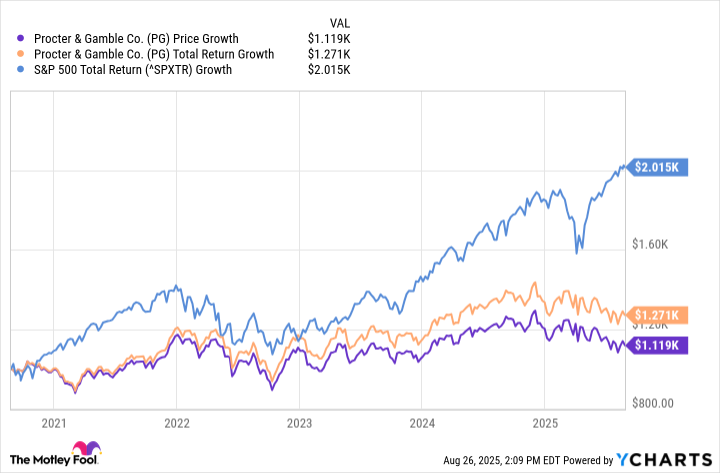Procter & Gamble (PG 0.51%) is not a stock widely followed by growth investors, though it has long been popular with those seeking income. Known for its Tide laundry detergent, Bounty paper towels, and Gillette razors, the company has increased its dividend for 69 consecutive years.
Still, market-beating stocks must rely on more than just their dividends as even this storied Dividend King has lagged the broad market in the past five years.

Image source: Getty Images.
Five years of holding Procter & Gamble stock
If you had invested $1,000 in Procter & Gamble stock five years ago, you would have about $1,270 as of this writing.

NYSE: PG
Key Data Points
Without the dividend, your position would only be worth around $1,120, meaning the payout, which now totals $4.23 per share annually, made up the bulk of its return. Indeed, the 69-year track record of payout increases and 2.7% dividend yield will make the stock attractive to some income investors, especially considering the 1.2% average yield of the S&P 500.
However, over the same period, the same investment in the S&P 500 would be worth $2,015 today, far outpacing the total return for Procter & Gamble.
Data by YCharts.
Admittedly, the consumer staples giant does not advertise itself as a growth stock. Procter & Gamble has existed since 1837, and it is a mature company selling common household goods, it tends to acquire more brands, raise prices, or rely on population growth to increase revenue. Moreover, consumers can easily find competing products, often at lower prices, meaning its competitive moat revolves around the strength of its brands. All of these factors effectively limit how fast it can grow.
Ultimately, for investors who value income and stability above all else, Procter & Gamble has its place as a buy-and-hold stock. However, an S&P 500 index fund has and will probably continue to offer higher returns overall, while there are also dividend-focused exchange-traded funds that can offer more attractive yields.







